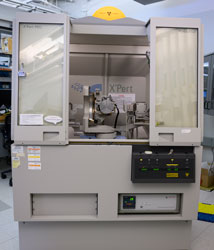
When a highly coherent X-ray beam is incident on a crystalline material, the periodic arrangement of atoms in the sample can cause the X-rays to diffract in certain specific directions. By measuring the angles and intensities of the diffraction beams, the sample's crystallographic information in terms of the lattice structure, lattice parameters, and basic atomic positions within the crystal structure's unit cell can be determined. XRD can be used to investigate of the arrangement of atoms within various metals, semiconductors, and insulators, provided they possess long range periodic ordering. This technique can also be used to investigate residual stress and preferred orientation analysis for metals and semiconductor materials.
- Panalytical X’Pert PRO
- High resolution X-ray diffraction with Cu Kα radiation
- Multiple X-ray optic options: mirror, hybrid, and microbeam optics
- Phase analysis of powder and thin film samples
- Residual stress and preferred orientation of flat surface samples
- In-situ heating stage (up to ~1000 °C)
Instrument Manager: Matt Wahila